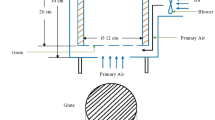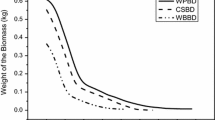Abstract
Testing the performance of biomass cookstoves is an important task in front of cookstove researchers. Different cookstove testing protocols are being used across the world for laboratory testing of the cookstoves. Most of the protocols recommend testing the stove at a fixed input power (kW) which is the product of fuel burning rate (kg/s) and calorific value (kJ/kg) of the biomass fuel. In actual field, the operator may operate the cookstove at any suitable input power. This causes difference in laboratory and field performance of the cookstove. Thus, single value of efficiency is not sufficient to describe the performance of a particular cookstove. To simulate actual cooking process through laboratory experiments, it is proposed to generate input power versus thermal efficiency characteristics of the cookstove. The present work involves detailed laboratory experiments on three natural draft biomass cookstoves viz. three stone fire, Panval rocket stove and Berkeley-Darfur stove. The experiments were performed on each cookstove according to modified Bureau of Indian Standards (BIS) Protocol. Each stove was operated at four different fuel-burning rates. Each test was repeated four times and uncertainty analysis was carried out using student’s t test. Input power versus thermal efficiency characteristics were plotted for the three cookstoves. These characteristics help the users to compare the performance of the cookstoves at a given fuel-burning rate.


Similar content being viewed by others
References
Abeliotis, K., & Pakula, C. (2013). Reducing health impacts of biomass burning for cooking-the need for cookstove performance testing. Energy Efficiency, 6, 585–594.
Action, Practical. (2010). Poor people’s energy outlook 2010. Rugby, UK
Amrose, S., Amrose, S., Kisch, G. T., Kirubi, C., Woo, J., & Gadgil, A. (2008) Development and testing of the berkeley darfur stove (No. LBNL-116E). Berkeley: Lawrence Berkeley National Lab.(LBNL).
Bailis, R., Ogle, D., Maccarty, N., Still, D. (2007). The water boiling test (WBT).
Bureau of Indian Standards (BIS). (1991). Indian Standards on Solid Biomass Chulha- Specification, IS 13152 (Part-1). New Delhi.
Bureau of Indian Standards (BIS). (2013). Indian standard on portable solid biomass cookstove (chulha) [first revision of 13152(Part 1):1991].
Census of India 2011. (2011). H series tables on census houses, household amenities and assets. New Delhi.
De, D., Shawhatsu, N., De, N., & Ajaeroh, M. (2013). Energy-efficient cooking methods. Energy Efficiency, 6, 163–175.
De, D., Nathaniel, M., De, N., Ikechukwu, & Ajaeroh, M. (2014). Cooking rice with minimum energy. Journal of Renewable and Sustainable Energy, 6(013138), 1–13.
Defoort, M., L’Orange, C., Kreutzer, C., Lorenz, N., Kamping, W., & Alders, J. (2009). Stove manufacturers emissions & performance test protocol (EPTP). Available at: http://www.cleancookstoves.org/our-work/standards-and-testing/learn-about-testing-protocols/protocols/downloads/eptp-protocol.pdf.
Dutta, K., Apartments, M., Shields, K., Edwards, R., & R., S. (2007). Impact of improved biomass cookstoves on indoor air quality near Pune, India. Energy of Sustainable Development, XI(2), 19–32.
Gupta, H. (2012). Crop residues management with conservation agriculture: potential, constraints and policy needs. New Delhi: Indian Agricultural Research Institute (IARI).
Kar, A., Rehman, I., Burney, J., Puppala, S., Suresh, R., Singh, L., Singh, V., Ahmed, T., Ramanathan, N., & Ramanathan, V. (2012). Real-time assessment of black carbon pollution in Indian households due to traditional and improved biomass cookstoves. Environmental Science & Technology, 46(5), 2993–3000.
Krishna Prasad, K., Sangen, E., & Visser, P. (1985). Woodburning cookstoves. Advances in Heat Transfer, 17, 159–317.
Kshirsagar, M., & Kalamkar, V. (2014). A comprehensive review on biomass cookstoves and a systematic approach for modern cookstove design. Renewable and Sustainable Energy Reviews, 30, 580–603.
Kumar, M., Kumar, S., & Tyagi, S. (2013). Design, development and technological advancement in the biomass cookstoves: a review. Renewable and Sustainable Energy Reviews, 26, 265–285.
MacCarty, N., Ogle, D., Still, D., Bond, T., & Roden, C. (2008). A laboratory comparison of the global warming impact of five major types of biomass cooking stoves. Energy for Sustainable Development, 12(2), 56–65.
Smith, K., Dutta, K., Chengappa, C., Gusain, P., Berrueta, O., Edwards, R., Bailis, R., & Shields, K. (2007). Monitoring and evaluation of improved biomass cookstove programs for indoor air quality and stove performance: conclusions from the household energy and health project. Energy of Sustainable Development, XI(2), 5–18.
Sutar, K., Kohli, S., Ravi, M., & Ray, A. (2015). Biomass cookstoves: A review of technical aspects. Renewable and Sustainable Energy Reviews, 41, 1128–1166.
Tribal Energy and Environmental Information Clearinghouse (TEEIC). (2017). (Accessed Aug. 2017) Available at: https://teeic.indianaffairs.gov/er/biomass/restech/uses/howuse/index.htm.
Water boiling test V.4.1.2. (2009). Cookstove emissions and efficiency in controlled laboratory setting. (Accessed 2009) Available at: http://www.pciaonline.org/files/WBT4.1.2_0_0.pdf.
Water boiling test V.4.2.2. (2013). Cookstove emissions and efficiency in controlled laboratory setting. (Accessed 2013) Available at: http://community.cleancookstoves.org/files/405.
Acknowledgements
The authors are grateful to the Management of Bharati Vidyapeeth and especially to Dr. Anand R. Bhalerao, Principal, Bharati Vidyapeeth (Deemed to be University) College of Engineering, Pune, for providing us an opportunity to carry out this research. The authors are also thankful to Mr. Mohaneesh R. Honavar, Mr. Ninad M. Desai and Prof. Datta B. Dandge, the inventors of Panval Rocket stove for providing us natural draft metal stoves for testing purpose.
Author information
Authors and Affiliations
Corresponding author
Ethics declarations
Conflict of interest
The authors declare that they have no conflict of interest.
Rights and permissions
About this article
Cite this article
Sutar, K.B., Singh, R., Karmakar, A. et al. Experimental investigation on thermal performance of three natural draft biomass cookstoves. Energy Efficiency 12, 749–755 (2019). https://doi.org/10.1007/s12053-018-9705-x
Received:
Accepted:
Published:
Issue Date:
DOI: https://doi.org/10.1007/s12053-018-9705-x




